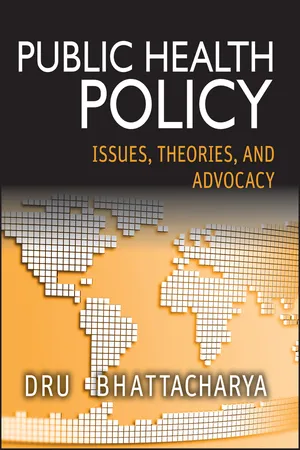
- English
- ePUB (mobile friendly)
- Available on iOS & Android
About This Book
Public Health Policy: Issues, Theories, and Advocacy offers students an engaging and innovative introduction to public health policy: its purpose, how it is originated, and how it is implemented. The book describes the underlying theories and frameworks as well as practical analytical tools needed for effective advocacy and communication. Drawing on the multidisciplinary nature of public health, the book uses concepts and examples from epidemiology, law, economics, political science, and ethics to examine the policymaking process, explain positions pro or con, and develop materials for various audiences to further a public health policy intervention. In addition, Public Health Policy shows how policymaking is a complex and integrated top-down and bottoms-up process that embraces a myriad of public and private stakeholders.
Written by a highly experienced health policy researcher and teacher, the book is rich in resources that will enhance teaching and learning. Each chapter begins with an overview of the chapter, including core terms and concepts, and includes illustrative examples of how the highlighted component (law, ethics, economics, politics, epidemiology, and medicine) intersects with public health. Discussion questions at the end of every chapter, along with an interview from an expert from each of the component fields, give real-world perspectives on how that particular subject relates to the overall topic. The book also contains 13 case studies that illustrate the framework discussed in the first part of the book, and show how the different components link to create, sustain, evaluate, or obstruct the development of public health policy. Also included are primers on two essential policy tools: how to write research policy briefs, and how to craft effective letters to an editor, including examples of both drawn from the author's publications in journals and newspapers.
Frequently asked questions
Information
Part 1
Building a Framework for Conducting a Multidisciplinary Analysis
Chapter 1
The Role of Law: Agencies, Legislatures, Courts, and the Constitution
- Define core legal terms and principles.
- Understand the structure of the US legal system.
- Articulate major legal powers and principles that are relevant to public health.
- Discuss major theories of public health law.
- Provide an introduction to statutory interpretation.
Defining Public Health Law
| Source | Definition |
| James A. Tobey (1947) | “Public health law may be defined as that branch of jurisprudence which treats of the relation and application of the common and statutory law to the principles, and procedures of hygiene, sanitary science, and public health administration.”5 |
| Lawrence Gostin (2008) | “Public health law [is] the study of the legal powers and duties of the state, in collaboration with its partners (e.g., health care, business, the community, the media, and academe), to ensure the conditions for people to be healthy (to identify, prevent, and ameliorate risks to health in the population), and of the limitations on the power of the state to constrain for the common good the autonomy, privacy, liberty, proprietary, and other legally protected interests of individuals.”6 |
| Oregon Revised Statutes (2008) | “‘Public health law’ means any statute, rule, or local ordinance that has the purpose of promoting or protecting the public health and that establishes the authority of the Oregon Health Authority, the Public Health Director, the Public Health Officer, a local public health authority or local public health administrator to enforce the statute, rule, or local ordinance.”7 |
… the study of the legal powers and duties of the state, in collaboration with its partners (e.g., health care, business, the community, the media, and academe), to ensure the conditions for people to be healthy (to identify, prevent, and ameliorate risks to health in the population), and of the limitations on the power of the state to constrain for the common good the autonomy, privacy, liberty, proprietary, and other legally protected interests of individuals. The prime objective of public health law is to pursue the highest possible level of physical and mental health in the population, consistent with the values of social justice.1
Table of contents
- Cover
- Table of Contents
- Title
- Copyright
- Introduction
- The Author
- Part 1: Building a Framework for Conducting a Multidisciplinary Analysis
- Part 2: Case Studies
- Part 3: Advocacy
- Index
- End User License Agreement